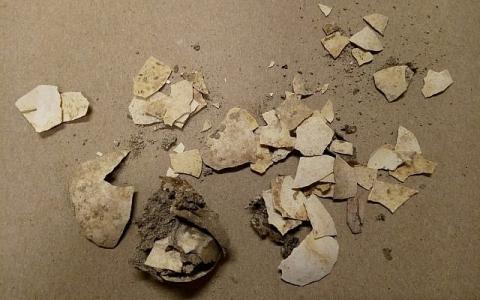High-tech reconstruction of unique eggshell trove from Jerusalem
Unlike Humpty Dumpty, the shells were successfully put back together recently through the use of high-tech 3-D virtual modeling. The implications of measurements garnered from this newly visualized ancient egg may well change concepts in halacha (Jewish law), according to Bar-Ilan University research released just ahead of the holiday of Passover.
For centuries, there has been an argument among halachic scholars beginning in the Mishnah (a 3rd-century CE codification of Oral Law) over how much unleavened bread (matzah) a person is required to eat during the festive first night Passover meal, or seder. The requirement is given as kazayit, or the size of an olive.
Over time, however, some European scholars unfamiliar with the fruit of the olive tree developed a workaround system based upon kebaitza, or the size of an egg. Until today, Lithuanian Jews living in Israel follow the ruling of the Mishna Berura (Rabbi Yisrael Meir Kagan, 1838–1933) and the Chazon Ish (Rabbi Avraham Yeshaya Karelitz, 1878-1953), which state that the size of an olive is 1/2 to 1/3 of the volume of an ancient egg.
But what was the size of an ancient chicken egg?
About a decade ago, archaeologist Dr. Eilat Mazar unearthed a trove of hundreds of eggshell pieces during excavations of an elite late First Temple period structure in Area G of the City of David. They were placed in the care of the head of Haifa University’s Archaeozoology Lab, Prof. Guy Bar-Oz, who confirmed that they were indeed chicken eggs. Due to their delicate fragility, the discovery of eggshells is rare and this is the first evidence of chicken eggs in the Holy Land.
However, the shells then sat until recent research conducted by Amar, who released the results ahead of an upcoming Bar-Ilan University archaeology conference on nature and agriculture in biblical Israel. Interestingly, the modern Hebrew word for chicken, tarnegol, does not appear in the Bible. The word comes from ancient Sumerian, where it literally means “the king’s bird.” By Talmudic times, a fowl species called sechvi in the Book of Job — considered by some to have been written circa the late 6th century BCE, close to laying of the City of David ancient eggs — was thought by the rabbis to be chickens.
Amar told The Times of Israel on Sunday that after he received the shells from Bar-Oz, he searched for a way to put the pieces together. Learning of new technology developed by the Israel Antiquities Authority to re-image pottery from a few indicative pieces, he contacted Dr. Avshalom Karasik who had worked out the new algorithm. Under the assumption that if the program could take several large pottery pieces and reconstruct a complete vessel from them, Amar asked if perhaps it could do the same with his eggshells.
Amar picked out four large egg shell pieces and Karasik’s virtual reconstruction illustrated that they all came from the same egg. Its measurements correspond to those of an average modern chicken egg. The height of the ancient egg was about 50 millimeters (2 inches), its maximum diameter was 40 millimeters, and the total size with the shell was 61 cubic centimeters, according to the Bar-Ilan release. (Amar said the study has a five percent error margin.)
Chickens lay a variety of egg sizes, according to their diet and health, but for comparison purposes, classifications of modern eggs run the gamut from 42 grams (small) to 57 grams (large), and the even larger 71 grams (jumbo). (Fun fact, the color of the egg shell corresponds to the hen’s ear color.)
The ancient egg’s 61 cc is well within modern egg measurements and so there is no reason to double the amount of matzah consumed based on the impression that ancient eggs were much larger.
Asked whether the new information on the size of the ancient chicken’s egg would affect his personal religious practice this Friday night regarding the amount of matzah he would consume, Amar laughed and said it would not as his Yemenite tradition is very close to the size of the modern egg.
Those who may be directly affect are Lithuanian Jews, he said, who believe the egg measure to be twice that of the modern size. But he laughed again and said he research will likely not affect their religious practices.
“I’m not sure they will change halacha according to what they read in the newspaper,” said Amar.
Amanda Morschel-Dan

